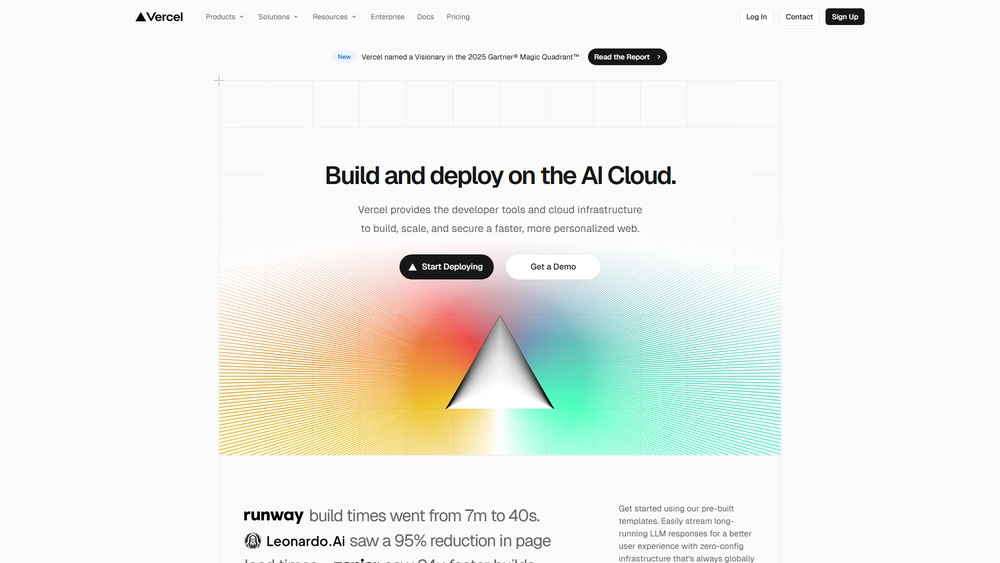Vercel Overview & 2025 Industry Position
Vercel has solidified itself as the de facto front-end cloud for developers who prize speed, scalability, and collaboration. Originally built to support and scale Next.js applications, Vercel has evolved into a platform that supports a diverse range of front-end frameworks, offering deep integrations, edge-first performance, and automatic CI/CD. In 2025, Vercel is positioned at the nexus of modern web development, composable architecture, and AI-powered dev workflows — providing teams a production-grade platform to build, preview, and ship with confidence.
From Launch to 2025: Vercel’s Journey
Founded in 2015 by Guillermo Rauch, Vercel (originally named ZEIT) focused on removing friction in deploying JavaScript apps. The pivotal launch of Next.js in 2016 positioned Vercel at the forefront of SSR (server-side rendering). Key milestones include:
- 2016 – Launch of Next.js open-source framework
- 2020 – Rebranded from ZEIT to Vercel; raised Series B funding
- 2021 – Introduced Edge Functions for globally distributed computing
- 2023 – Rolled out Vercel AI SDK, simplifying GenAI integrations
- 2024 – Released Vercel KV and Blob storage for full-stack capabilities
In 2025, Vercel’s strategy centers on being the go-to frontend cloud in a composable, AI-assisted web economy — where speed, scale, and seamless DX define success.

Vercel Key Features
Vercel’s platform empowers developers to build and deploy performant frontends with minimal overhead. Notable features include:
- Next.js-native Support – Seamlessly run and scale Next.js sites with hybrid rendering.
- Edge Functions – Run custom logic globally at the edge for ultra-low latency.
- Vercel AI SDK – Harness GenAI APIs (e.g., OpenAI, Claude) with React-style tools.
- Instant Preview Deployments – Automatic preview URLs per git commit or pull request.
- Visual Editing via Vercel Spaces – Enable marketing teams to edit content visually without devs.
- Integrated Observability – Built-in analytics and performance monitoring, including Core Web Vitals.
- Starter Templates & Boilerplates – Pre-built apps across frameworks for fast starts.
Workflow & UX
Vercel is designed for developer joy. With intuitive Git-based workflows, frictionless CI/CD, and VS Code integrations, the DX (developer experience) stands out. The platform auto-detects frameworks, sets up builds, and spins up preview environments with no extra config. Web mentions and real-user feedback flow directly into environments, enabling rapid testing and iteration. Vercel Spaces lets non-tech content editors collaborate visually on production-ready projects.
Pro Tip: For teams using multiple frontend tools, Vercel’s monorepo support with Turborepo boosts build speed dramatically — especially on enterprise-scale projects.
Vercel Pricing Analysis & Value Metrics
As of July 2025, Vercel offers pricing tiers suitable for individual developers to mid-size teams and enterprise deployments:
| Plan | Monthly Price | Key Inclusions |
|---|---|---|
| Hobby | Free | 1 user, preview deploys, Next.js support, edge deploys |
| Pro | $20/user | Team features, performance insights, password protection |
| Business | $250/month | Custom domains, concurrency scaling, conditional routing |
| Enterprise | Custom | SLAs, SSO, VPC, custom limits, account manager |
Value Assessment: Developers get immense value from the free plan alone, but Pro and Business tiers unlock productivity gains that pay off for growing teams.
Competitive Landscape
| Platform | Best For | Key Differentiator |
|---|---|---|
| Vercel | Front-end devs, React/Next.js teams | Native Next.js, global edge infra, AI SDK |
| Netlify | Jamstack sites, static apps | Integrated CMS workflows |
| Cloudflare Pages | Developers needing extreme edge performance | Full edge routing, Workers AI |
| Render | Bare-metal flexibility | Managed databases, backend services |
Common Use Cases
- Marketing sites with fast global page loads
- SaaS apps scaling with hybrid rendering
- eCommerce frontends with AI-powered search
- Docs portals needing real-time preview deploys
- Agency clients using visual editing via Vercel Spaces
Vercel Integrations
Vercel pairs effortlessly with key tools across the development and business stack:
- Content: Sanity, Contentful, Strapi, and Prismic
- CMS/eCommerce: Shopify Hydrogen, BigCommerce, WordPress Headless
- Git Tools: GitHub, GitLab, Bitbucket
- Observability: Sentry, LogRocket, DataDog
- Payments: Stripe SDKs, PayPal, Paddle
Pros & Cons
- Pros:
- Blazingly fast builds and deploys
- Instant preview URLs per commit
- Zero-config support for frontend frameworks
- Visual editing and AI SDK support
- Global scalability via edge nodes
- Cons:
- Advanced usage may require understanding of SSR nuances
- Business tier limits could be restrictive for high-concurrency apps
- Enterprise customization can get pricey
Final Thoughts
Vercel empowers product teams, startups, and enterprises alike to ship faster and collaborate smarter in 2025. Its modern developer-first cloud, edge capabilities, native Next.js CI/CD, and rapid preview flows make it ideal for frontend-focused organizations. While alternative platforms match features in isolation, Vercel deployments outperform thanks to deep framework integration and superior UX. The tradeoffs? Slight learning curve for SSR intricacies and enterprise-tier pricing — but for mission-critical frontends, the ROI is unmistakable.
Vercel FAQ
No. While Vercel is optimized for Next.js, it also supports frameworks like Astro, SvelteKit, Nuxt, and static HTML/JS projects.
Yes. Vercel offers KV, Blob, and Postgres storage services, cron jobs, and edge/serverless functions to support full-stack functionality.
Both offer frontend hosting, but Vercel is more opinionated toward Next.js and AI workflows, while Netlify emphasizes Jamstack and headless CMS integration.
Vercel apps are deployed to edge nodes globally, running logic close to end users using Edge Functions and smart routing.
Yes. The Hobby tier is completely free, perfect for personal projects and side hustles, with generous build limits and preview deploys.

